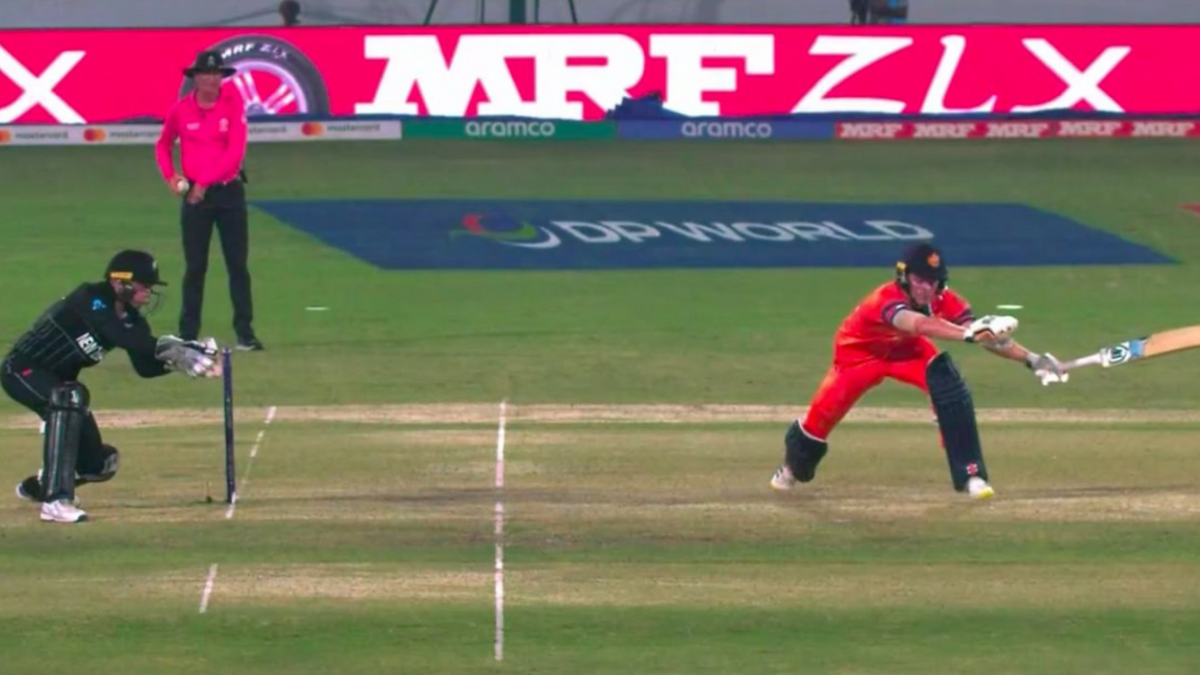
New Zealand’s routine victory was marked by a moment of controversy, with TV umpire Joel Wilson criticised for his decision on a Tom Latham stumping appeal.
Here’s why Wilson made the right call, contrary to much of the debate online and on commentary.
What happened – The Tom Latham stumping appeal and the review
Netherlands, chasing 323 to win, were 197-7 in the 41st over. ODI debutant Sybrand Engelbrecht advanced down the track at Rachin Ravindra, who saw the batter coming, fired the ball wide on the off-side, with Latham collecting the ball and taking off the bails.
The onfield umpires, Paul Reiffel and Rod Tucker, signalled ‘wide’ and then reviewed the stumping decision upstairs. While Engelbrecht was clearly out of his ground, Wilson focussed on the position of the wicketkeeper. “Take it back, it looks like he has collected the ball in front of the stumps,” he said during the review. “I’m checking, where are the gloves when he is collecting it? He’s not wholly behind the stumps, so I have a no-ball and the batsman will be not out.”
New Zealand went on to wrap up a 99-run win.
Why was there controversy?
The official ICC commentators could be heard in the background during the Wilson review aghast at the decision that was about to be made, with Ian Smith, a former New Zealand wicketkeeper, making his displeasure clear as he returned to the microphone.
“Well, I’ve got to say, as a former wicketkeeper, that’s the most bizarre thing I’ve ever seen,” he said. “That is just crazy. When the ball went into the gloves, they were clearly, clearly behind the stumps. They might have been initially in front, but when the ball went into the gloves, clearly behind the stumps. Look at the gloves there. Are you telling me it’s a no ball? Well, when I look in the paper tomorrow it will say it, but not for mine.”
There was also criticism of the decision on social media, with many agreeing with Smith’s assessment that Wilson had made an error. “This is becoming like rugby union,” Smith added, referring to a series of controversies during the ongoing Rugby World Cup. “The officials just can’t stay out of it.”
Did Wilson make a mistake? Here’s what the laws say
Much of the scrutiny focussed on Latham’s position as the ball entered his gloves, but the Laws of Cricket make clear that this is not the only thing that matters.
Law 27 concerns the wicketkeeper, with clause 27.3 dealing with what position the gloveman must take. “The wicketkeeper shall remain wholly behind the wicket at the striker’s end from the moment the ball comes into play until a ball delivered by the bowler touches the bat or person of the striker or passes the wicket at the striker’s end or the striker attempts a run,” it states. “In the event of the wicket-keeper contravening this Law, the striker’s end umpire shall call and signal No ball as soon as applicable after the delivery of the ball.”
It is up for debate whether Latham was behind the stumps when the ball entered his gloves, but, as Smith himself noted, he did pass in front of the stumps as the ball was coming down. Therefore the decision was correct.
It is arguable whether Wilson’s wording was helpful, given he specifically referenced the location of the gloves at the point of collection, but there is no doubt that Engelbrecht was rightly reprieved.
There was no clarification of the Laws of Cricket in question on commentary for the remainder of the game.








